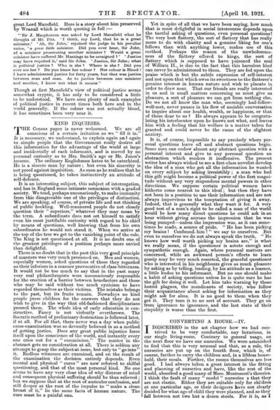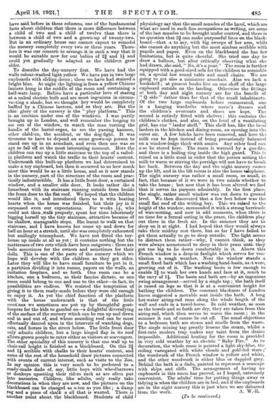CONVERTING A HOUSE.—IV.
T DESCRIBED in the ast chapter how we had con- trived trived to be very comfortable, nay luxurious, in our single living-room. Contrary to general usage, on the next floor we have our nurseries. We were astonished to find that this is very unusual and that, as a rule, the nurseries are put up on the fourth floor, which is, of course, farther to carry the children and, in a liftless house- hold, their meals. Further, the rooms themselves are less good. I had always taken a great interest in the fitting and planning of nurseries and have, like the rest of the world, absorbed a good many of Mme. Montessori's theories. I think the fault of many " model " nurseries s that they are not elastic. Either they are suitable only for children at one particular age, or their designers have not clearly decided for what age of child they were planned, and so they fall between not two but a dozen stools. For it is, as I have said before in these columns, one of the fundamental facts about children that there is more difference between a child of two and a child of twelve than there is between a child of two and a grown-up of twenty-two. But in an ordinary house one cannot expect to remodel the nursery completely every two or three years. There- fore it was our concern to arrange it in such a way that it would be suitable now for our babies of 21 and 11 and could yet gradually be adapted as the children grew older.
To describe the day-nursery first. We have had the walls colour-washed light.yellow. We have put in two largo cupboards with sliding doors ; these we have had stained a bright blue. At night the lighting is from a yellow Chinese lantern hung in the middle of the room and containing a half-watt lamp. Babies have a particular love of staring at a naked electric bulb and are most ingenious in circum- venting a shade, but we thought - hey would be completely baffled by a Chinese lantern, and so they are. But the chier glory of the nursery is the " play platform." This is an erection under one of the windows. I was partly brought up in London, and well remember the longing to see out of the window, to watch the man turning the handle of the barrel-organ, to see the passing hansom, other children, the accident, or the dog-fight. It was tiresome to have to depend on some grown-up person to stand one up in an armchair, and even then one was so apt to fall off at the most interesting moment. Here the children can run up a little staircase to the top of a railed- in platform and watch the traffic to their hearts' content. Underneath this built-up platform we had determined to make a toy cupboard, but then it occurred to us how much nicer this would be as a little house, and so it now stands in the nursery, part of the structure of the room and prac- tically indestructible. It has a little front door, a curtained window, and a smaller side door. It looks rather like a houseboat with its staircase running outside from beside the front door to the flat roof. We hoped that the children would like it, and introduced them to it with beating hearts when the house was finished, but their joy in it surpassed even our expectations. For weekswho could not then „walk properly, spent her time laboriously lugging herself up the tiny staircase, attractive because of its shallow, manageable steps. She learnt to walk on that staircase, and I have known her come up and down for half an hour at a stretch, until she was completely exhausted but smilingly triumphant. We have not fitted tho toy- house up inside at all as yet ; it contains nothing but the mattresses of two cots which have been outgrown : these are beds sometimes for the owners and sometimes for their dolls. This is one of the parts of the nursery which we hope will develop with the children as they get older. Later they will' like to have small furniture to put in it, a partition dividing it into rooms, papers on the walls, an imitation fireplace, and so forth. One room can be a kitchen, one a bedroom, as their fancies dictate, or one room could belong to one and one to the other—in fact, its possibilities are endless. We resisted the temptation of giving it to them ready-made before they were old enough to enjoy it. As yet the chief function of the platform with the house underneath is that of the little erections we sometimes see put up by thoughtful goat- keepers for the kids to gambol on—a delightful diversifying of the surface of the nursery which can be run up and down and in and out of, and whose sounding roof can be most effectually danced upon in the intervals of watching dogs, cats, and horses in the street below. The little front door only admits children, but a large hinged flap in its roof allows grown people to enter either as visitors or scavengers. The other speciality of this nursery is that one wall up to chair-rail height is finished. as a blackboard.. On this 21 and 11. scribble with chalks to their hearts' content, and some of the rest of the household draw pictures connected with events of current interest, such as visits to the Zoo. In my opinion this is very much to be preferred to a ready-made dado of, say, little boys with wheelbarrows or donkeys upsetting their riders such as are often put Into nurseries. Children, like adults, only really take decorations in when they are new, and the pictures on the blackboard can be changed as often as you like ; a damp rag and a piece of chalk Is all that is wanted. There is another point about the blackboard. Students of child physiology say that the small muscles of the 1paid, which are what are used in such fine occupations as writing, are some of the last muscles to bo brought under control, and there is no question that 21 can make purposeful lines on the black- board—that to say, with big sweeps of her arm, while she cannot do anything but the most aimless scribble with pencils and paper. Even on the blackboard she has her limitations, but is quite cheerful. She tried one day to draw a balloon, but after critically observing what she had drawn, she said, " No, it's a pear." The room is further equipped with a good-sized sofa for the children to scramble on, a special low round table and small chairs. We are going to get also a miniature armchair. Also we lack a bookshelf ; at present books live on one shelf of the large cupboard outside on the landing. Otherwise tho fittings of both day and night nursery are for the benefit of " Q side " rather than for that of the small inhabitants. Of the two largo cupboards before enumerated, one is a hanging wardrobe where nurse's dresses and the children's overcoats and shoes are kept. The second is entirely fitted with shelves ; this contains the children's clothes, and also, on the level of a ventilating grid, has one " larder shelf." This shelf has, like the local larders in the kitchen and dining-room, an opening into the outer air. A few bricks have been removed, and here the milk can be kept instead of being precariously balanced on a window-ledge thick with smuts. Any other food can nso be stored here. The room is warmed by a gas-fire, and there is a boiling ring inside the high guard. This is raised on a little stool in order that the person setting the milk to warm or stirring the porridge will not have to break her back. Between the day and the night nursery comes up the lift, and in the lift recess is also the house takp hone. The night nursery was rather a small room, so small, in fact, that because of it we were in two minds whether to take the house ; but now that it has been altered we find that it serves its purpose admirably.. In the first place, the single, rather small window was cut down to ground level. We then discovered that a few feet below was the small flat roof of the writing bay. This we raised to the height of the window, surrounded it with a strong barricade of wire-netting, and now in odd moments, when there is no time for a formal outing in the pram, the children play out there in the fresh air. In the summer they are to sleep on it at night. I had hoped that they would always take their midday rest there, but so far I have failed to get them actually to go to sleep outside. The light seems to distract them. rather—why, I cannot think, as they were always accustomed to sleep in their pram until they got too big to lie down comfortably in it. Above this French window is a drop-in fanlight which serves for ven- tilation n rough weather. Near the window stands a small fixed bath which has a washing hand-basin, as it were, growing out of it. The washing basin is low enough to enable 21 to wash her own hands and face at it, much to the envy of The basin and bath are—by an ingenious swing arrangement—served by a single tap ; the bath itself is raised on legs so that it is at a convenient height for bathing the children. The constant blackness of London knees suggested a movable seat inside the bath. A long hot-water airing-rail runs along the whole length of the wall and ends in a towel-horse. In cold weather, as soon as the towels and so forth are dry, they are taken from this airing-rail, which then serves to warm the room ; in the summer it can of course be cut off. The usual objections to a bedroom bath are steam and smells from the waste. The single mixing tap greatly lessens the steam, whilst a first-rate modern trap makes any taint from the drains impossible. Additional heating for the room is provided in very cold weather by an electric " Baby Fire.' As to decoration, the whole room is painted a light sky-blue, the ceiling variegated with white clouds and gold-foil stars ;' the woodwork of the French window is yellow and white, and the other woodwork is either blue or dappled grey. Behind the bath is a dado, painted to represent a seascape with ships and cliffs. The arrangement of having no cupboards in this room has proved, as I hoped, extremely convenient. The adults' time for putting things away or tidying is when the children are in bed, and if the cupboards are in the night nursery this is just when we aro debarred from the work. A. W (To be continued.) .-E.



































 Previous page
Previous page